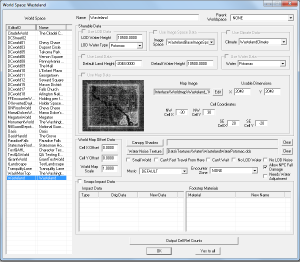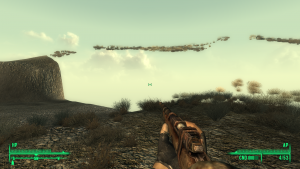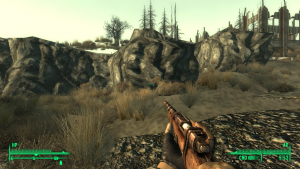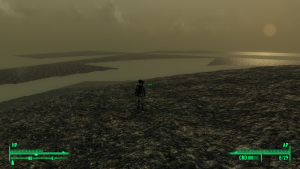World Spaces
Contents
World Spaces Dialog
A world space is simply an entire world, with its own landscape, sky and weather. All exterior cells belong to a worldspace -- in Fallout 3, most of the exterior cells are in the Wasteland worldspace, but there are many more worldspaces used in the game, and adding a new worldspace is relatively simple.
Worldspaces can share landscape with a Parent worldspace (for example, many of the settlement worldspaces, such as Megaton and Paradise Falls, have Wasteland as a parent), or they can use an entirely different landscape (for example, Tranquility Lane).
Note: Always save your plugin before or immediately after creating a new worldspace. If you don't, and you edit the heightmap for your worldspace, the GECK will crash.
Information about the various fields is provided below.
Data Fields
- World Space: A list of available world spaces by editor ID. To create a new world space, right click on the list and choose 'New' to create a blank world space or 'Duplicate' to duplicate an existing world space and it's current options. You can give your world space any editor ID you like; it will not appear in the game.
- Name: In-game name of the world space. This name appears whenever you enter the world space from a different world space.
- Parent Worldspace: If your world space is to be a sub-space of an existing world space (like Megaton, which is a sub-space of the Wasteland), you may select the parent world space here. Child world spaces may inherit some or all of a parent world space's data by checking the appropriate boxes in the Sharable Data group.
Sharable Data - Use the check boxes to inherit these attributes from a parent world space if a parent world space has been selected. Otherwise, you may manually enter your own values.
- Use LOD Data: Check this box to inherit LOD data from the parent world space.
- LOD Water Height: Elevation that LOD water appears. In most cases, this should match the height set for water in the Use Land Data group. If your world space does not use LOD water, you can leave this set at 0.
- LOD Water Type: Select the WaterType for LOD water. In most cases, this should match the Water Type of the world space set in the Use Water Data group.
- Use Image Space Data: Check this box to inherit imagespace data from the parent world space.
- Image Space: Adds cinematic effects to the world space. See ImageSpace.
- Use Climate Data: Check this box to inherit climate data from the parent world space.
- Climate: Select the Climate for this worldspace.
- Use Land Data: Check this box to inherit land data from the parent world space.
- Default Land Height: Set the default land height.
- Default Water Height: Set the default water height. To avoid rendering errors with autowater, it is recommended that you set this value to at least 10500.
- Use Water Data: Check this box to inherit water data from the parent world space.
- Water: Select the WaterType used in this worldspace.
Use Map Data: Check this box to inherit map data from the parent world space.
- Map Image: If you want a custom world map, select the DDS file by clicking the Edit button.
- Usable Dimensions: Specify the usable dimensions of the map image. Dimensions are measured in pixels from the upper left corner to the lower right corner.
- Cell Coordinates: Specify which cells occupy the upper left and lower right limits of the map.
World Map Offset Data
- Cell X Offset: Offset the starting x coordinate.
- Cell Y Offset: Offset the starting y coordinate.
- World Map Scale: Adjust the scale of the world map.
- These options allow the map marker(s) to be positioned at the desired location on the world map regardless of the coordinates of the worldspace.
- Canopy Shadow: Sets the canopy shadow texture for the world space. (A canopy shadow is a shadow cast by dense foliage.)
- Water Noise Texture: Sets the water noise texture for the world space. This texture should match the water noise texture set for the WaterType used in the world space. If this setting is incorrect, the editor will complain about mismatched water noise textures. Failure to set a water noise texture will cause the game to CTD.
- Small World: Marks this as a small worldspace. Reduces memory usage for small worldspaces.
- Can't Fast Travel From Here: No fast travel from this worldspace. This flag can also be set on a cell by cell basis.
- Can't Wait: No waiting in this worldspace.
- No LOD Water: Disable LOD water (for worldspaces where there is no water or where the view is restricted).
- No LOD Noise: Disable LOD water noise (for worldspaces where there is no water or the view is restricted).
- Allow NPC Fall Damage: If this box is checked, NPCs will take damage from falls in this worldspace. For settlement world spaces, it is recommended that you deselect this option to avoid unnecessary NPC deaths.
- Needs Water Adjustment: This appears to be a new feature of GECK 1.5 and needs to be tested.
- Music: Set the music type for this worldspace. This feature is deprecated in Fallout: New Vegas, use audio markers instead.
- Encounter Zone: Set the encounter zone to be used in this worldspace.
- Swaps Impact Data: Allows swapping the impact data for Havok material types
- Impact Data: The material type, original impact data, and new impact data
- Footstep Materials: the footstep material name and new footstep material name, these correspond to sound records for footsteps. The sound names must start with the prefix FST and the name of new material. There are sound suffixes for each type of action, they are listed below.
- Land: The sound(s) to be made when landing from a fall or jump.
- RunL: The sound(s) to be made by the left foot when running.
- RunR: The sound(s) to be made by the right foot when running.
- SneakL: The sound(s) to be made by the left foot when sneaking.
- SneakR: The sound(s) to be made by the right foot when sneaking.
- WalkL: The sound(s) to be made by the left foot when walking.
- WalkR: The sound(s) to be made by the right foot when walking.
- StairsL: The sound(s) to be made by the left foot when going up or down stairs. (Fallout 3 only)
- StairsR: The sound(s) to be made by the right foot when going up down stairs. (Fallout 3 only)
- Note: Sounds can either be a file or a directory, in the case of a directory the sounds there-in will be played randomly.
- Output Cell Ref Counts: Creates a text file containing the number of references contained in each cell. Probably used for optimization.
World Space Issues and Workarounds
AutoWater Generation Errors
World spaces with a default water height set below 10500 tend to have errors in the water mesh causing 'gaps' (missing polygons). The area below the water line still behaves correctly, but the water mesh itself does not render properly. It is not known what causes this error. To avoid it, always set your default water height (and ideally, your default lod water height) to a value >= 10500. The Wasteland worldspace uses this setting, though individual cells sometimes have water raised above this level.
LOD Tree Errors
It is important to make sure that the default land height of any new worldspace is created above a coordinate of 13000z. At coordinates below 13000z you will find floating trees as part of the wasteland LOD when you generate a LOD for your own worldspace.
This point requires additional investigation. It is worthwhile to note that all of the child world spaces that have the Wasteland as a parent have a default land height of 12288, so this issue may have plagued Bethesda as well.
Tree and Object LOD
Note that TreeLOD was not used to generate LOD in Fallout: New Vegas and everything (including trees) is Object LOD and will require object billboards for any trees, SpeedTree or otherwise. TreeLOD is generally pretty ugly and always generates standing billboards regardless of the ref placement, so Object LOD is preferred almost all cases.



